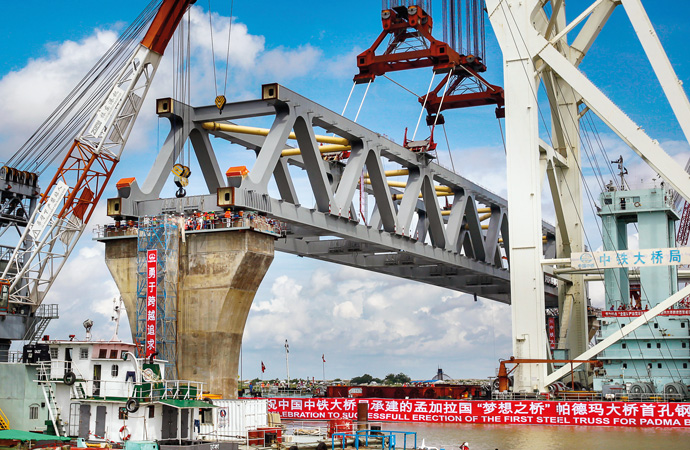
By Prof. Swaran Singh/Ceylon Today 10 January 2019
Tuesday saw Sheikh Hasina being sworn in as Prime Minister of Bangladesh for the historic fourth time, and for the third consecutive term since 2009. Now, as her 41-member Council of Ministers – that includes 37 new faces – hits the ground running to fulfill her promised double-digit growth for the already booming economy the heat and dust of alleged riggings, mass arrests and intimidations during the elections will give way to analysis about her likely legacies and their implications for regional geopolitics.
The success of Sheikh Hasina’s last ten years of prime ministership is already widely acknowledged with Bangladesh Development Model becoming the new creed. With her Awami League and allies now winning an overwhelming majority of 288 out of 299 elected members in their 300-strong national assembly, nothing is likely to stop her ambitious strides.
This fourth term would make her one of world’s longest-serving democratically elected prime ministers but much more is expected from her both by her supporters and critics alike. Conversely, the complete decimation of Opposition Bangladesh National Party – that boycotted 2014 elections and won no more than seven seats this time – has made it vulnerable to aligning with legally de-recognized parties like Jamat-e-Islami and there are concerns about one-party rule bringing together such radical outfits.
For South Asia, the most tectonic shift will see Bangladesh emerge as the second largest economy pushing nuclear Pakistan to the third position. With Pakistan and Bangladesh currently growing respectively at 5.5 and 7.86 per cent, the current gross national product (GDP) of $275 billion of Bangladesh seems set to cross Pakistan’s $305 billion economy.
Comparisons become more acute in exploring other indices. Pakistan’s 200 million people compared to 165 million Bangladeshis makes their per capita GDP represent a whole new reality: Bangladesh’s $1,800 per capita GDP had long surpassed Pakistan’s $1,600 per capita GDP. From being a least developed country (LDC) Bangladesh has come to be categorized as rapidly developing middle income economy.
Bangladesh’s exports have made impressive strides reaching $36 billion for 2018 compared to Pakistan’s $21 billion, their public debts standing respectively at $32 billion and $62 billion each. The new prime minister of Pakistan Imran Khan inherited rapidly shrinking foreign exchange reserves of around $14 billion while Bangladesh foreign exchange reserves reached #32.93 billion for 2018. Fear of default on payments has seen Imran Khan shuttling between China, Saudi Arabia, and international financial institutions requesting for a bailout – and the United Arab Emirates this week finalized a $6.2 billion package – Bangladesh has become an attractive destination for investments and developmental partnerships.
India, China and Southeast Asian tiger economies
Bangladesh is seen today building economic partnerships with India, China and Southeast Asian tiger economies. Pakistan, on the other hand, has got itself embroiled in the quagmire of unending low-intensity conflicts with both its neighbor countries – India and Afghanistan –resulting in the economic declaration and internal instability. For regional cooperation, in the early 1980s, Bangladesh took lead in setting up the South Asian Association for Regional Cooperation (SAARC). Pakistan’s problems with India have resulted in discontinuation of SAARC summits since 2016.
With India’s newfound enthusiasm and search for alternate regional formulations, Bangladesh has become an important player in BBIN (Bhutan-Bangladesh-India-Nepal) initiative as also in BIMSTEC i.e. Bay of Bengal Multi-Sectoral Technical and Economic Cooperation. BIMSTEC secretariat in Dhaka has become hyperactive in building new synergies between five SAARC nations – Bangladesh, Bhutan, India, Nepal, and Sri Lanka – and Southeast Asia’s Myanmar and Thailand. BIMSTEC is seen expanding beyond its limited mandate of economic and technical cooperation. The 4th BIMSTEC summit in Kathmandu included issues like transnational security challenges and the first BIMSTEC joint military exercise was held in Pune (in India) last year.
Rohingya crisis also saw Hasina taking the lead. Bangladesh played an exemplary role in accepting over 600,000 Rohingya refugees. While India adopted a cautious approach in not accepting and even deported Rohingyas, Sri Lanka is another South Asian country that has accepted Rohingya refugees during 2008, 2013, 2017. President Sirisena’s visit to Dhaka in July 2017 underlined their partnership that has been followed by an impressive rise in mutual trade and investments since 2014 making them important players in South Asian geopolitics and, in spite of being seen as pro-India, both have successfully managed to equidistance between New Delhi and Beijing inviting investments from both sides.
China’s Belt and Road Initiatives – another game changer for South Asian geopolitics – has received far greater traction in the eastern flank of South Asia compared to the western flank that remains intertwined with India-Pakistan rivalries.
So, while India remains opposed to China-Pakistan Economic Corridor – and is not likely to join the second edition of the Belt and Road Forum for International Cooperation to be held in Beijing during April 2019 –New Delhi remains positively inclined to the BCIM (Bangladesh-China-India-Myanmar) Economic Corridor. China short-circuiting BCIM by creating a China-Myanmar Economic Corridor has seen India’s studied silence. China is hopeful of seeing its ‘Two-Plus-One’ model leading to joint China-India ventures in all South Asian countries including Sri Lanka and the economic rise of Bangladesh promises to facilitate such a possibility.
(Writer is a Professor at the Jawaharlal Nehru University, New Delhi)
